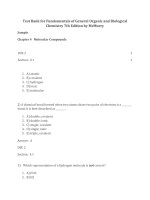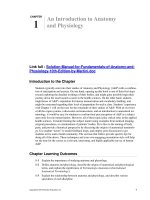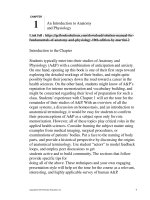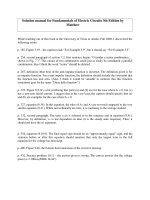Test bank and solution manual for fundamentals of general organic and biological chemystriy 7e (2)
Bạn đang xem bản rút gọn của tài liệu. Xem và tải ngay bản đầy đủ của tài liệu tại đây (134.68 KB, 5 trang )
Chapter 2 - Atoms and the Periodic Table
Overview
Chapter 2 introduces the theories of atomic structure and electron distribution
used to place elements in the periodic table and predict their physical and chemical properties.
Introduction for Instructors
• An understanding of atomic theory and electron distribution is essential to later predictions of
chemical activity.
• Placement of elements in the periodic table by determination of electron distribution allows
linking of concepts, making them more understandable.
• Students commonly confuse the terms isotope and radioisotope.
• If you want to generate discussion, you will probably find a few students who are personally
interested in creation accounts and want to explore the subject. Suggest that they compare the
story of Gilgamesh with other creation myths.
• You may wish to note that scientists know a great deal more about atomic structure than we
usually discuss. Knowing more about the structure of atoms may eventually help solve some
of the more serious problems we encounter in medicine, energy production, and the
environment.
Chapter Goals
• To understand and explain major assumptions of atomic theory
• To be able to explain composition of atoms based on numbers of protons, neutrons and
electrons
• To be able to relate atomic weight to isotope composition
• To understand:
-How electrons are distributed in atoms
-How the elements are placed in the periodic table according to electron distribution
-Why elements are placed in subdivisions
-General trends in atomic mass and diameter
Lecture Outline
2.1 Atomic Theory
• All matter is composed of very small particles we call atoms.
• Atoms of an element are similar and different from those of other elements.
• All atoms of a particular element contain the same numbers of electrons and protons.
• Chemical compounds are made up of specific combinations of atoms.
• Chemical reactions change the way atoms are combined, but don’t change the composition.
• Most of the mass of atoms is in the nucleus, made up of protons and neutrons.
• The mass number (A) of an atom is the sum of the protons and neutrons present.
• Different elements have nuclei containing different numbers of protons.
Copyright © 2013 Pearson Education, Inc.
7
Chemistry in Action – Are Atoms Real?
• A series of historic experiments has verified atomic theory.
• Scanning tunneling electron microscopy now allows visualization of atoms.
2.2 Elements and Atomic Number
• Atoms of different elements have different numbers of protons (the atomic number, Z).
• The mass number (A) is the sum of protons and neutrons in an individual atom.
2.3 Isotopes and Atomic Weight
• A particular isotope has a certain number of protons and neutrons (the mass number, A).
• Many elements have isotopes having identical numbers of electrons and protons, but different
numbers of neutrons (different A numbers).
• The average of atomic masses of isotopes of an element is called the atomic weight.
2.4 The Periodic Table
• Many elements have been known for centuries, others were only discovered recently.
• Early scientists noted similarities between elements and tried to place them in groups.
• Dmitri Mendeleev grouped elements according to increasing atomic number, producing a
periodic table very similar to the present form.
• Elements in the periodic table are arranged in vertical columns called families.
• Horizontal rows are called periods.
2.5 Some Characteristics of Different Groups
• Diameters of atoms increase from top to bottom of a family of elements in the table.
• Group 1A elements are called alkali metals. They are soft and shiny, and react with water.
• Group 2A elements are the alkaline earth metals.
• Group 7A elements are called halogens; they tend to be corrosive and poisonous when free.
• Group 8A elements are called the noble gases and resist reaction.
• Most elements are metallic and found in the lower left portion of the table.
• Metals have characteristics which set them apart from nonmetals.
• Nonmetals, located in the upper right portion, are usually brittle and nonconductive.
Chemistry in Action– The Origin of Chemical Elements
• Most astronomers believe that the universe is about 15 billion years old and that the atoms
of matter around us were formed in stars.
2.6 Electronic Structure of Atoms
• Electrons are grouped around nuclei in energy levels or shells.
• Each shell has one or more sublevels or subshells; each subshell is divided into orbitals.
• The properties of elements are determined by the arrangement of electrons in energy levels.
Copyright © 2013 Pearson Education, Inc.
8
2.7 Electron Configurations
• We visualize models of atoms in which the electrons occupy the lowest energy orbitals.
• Energy levels are assigned designations, and in building from simple atoms to complex, we
imagine the electrons going into the orbitals having lowest energy designations.
• When atoms react, they add or lose the electrons in their highest energy orbitals.
• Electrons occupy the lowest energy orbitals available (their ground state).
• Each orbital can contain only two electrons.
• Within a subshell, each orbital must contain one electron before any can contain a second.
• Orbitals are classified as s, p, d, and f and have specific shapes.
2.8 Electron Configurations and the Periodic Table
• Blocks of elements in the periodic table can be referred to as the s-block, etc., due to the
filling of orbitals within that block.
• Each portion of the periodic table corresponds to an outermost set of orbitals.
• The representative elements are those in which the outermost orbitals are s or p orbitals.
• d-Block elements are referred to as the transition metals, and f-block elements are called
the rare earth elements or inner transition elements.
2.9 Electron-Dot Symbols
• Electron-dot symbols are a convenient method of representing atoms or ions in reactions.
• Only the valence (outermost) electrons are shown in electron-dot symbols.
Chemistry in Action Atoms and Light
• Light, a form of electromagnetic energy, interacts with atoms in ways that allow us to measure
some properties of matter.
• Excited atoms emit light of characteristic wavelengths. We can use this to determine both
what sort of atoms are present in a sample and the amount of atoms present.
• The frequency of light waves is inversely proportional to the energy carried. Long waves,
such as infrared or radio waves, carry low energy. Short waves, such as X-rays, carry high.
Chapter 2 - Lecture Demonstrations
• Introduce the periodic table by using a recording of Tom Lehrer’s parody of the song from
HMS Pinafore (“There’s antimony, arsenic….”) .
• Some instructors use a cathode ray tube to illustrate a beam of electrons. These tubes may
produce soft X-rays and are not generally available now. Beam deflection tubes such as the
Cenco Mass of Electron Apparatus #30818N may be used instead, if available.
• Use salts such as CuCl2, NaCl, KCl, and SrCl2 to show colors produced by elements when
electrons are excited. Sift a small portion of the salt from your hand or a spatula into a flame
from a burner or from an alcohol flame.
Copyright © 2013 Pearson Education, Inc.
9
•
•
•
•
•
•
•
•
•
•
•
For a dramatic effect, prepare an alcohol gel by pouring 120 mL of 95% (v/v) ethanol from a
250 mL beaker into 20 mL of 80% saturated (58g salt in 200 mL water) calcium acetate in
another 250 mL beaker. With a little practice, you can time the pouring so that on the second
or third pour, the solution gels, forming a flammable mixture similar to the various canned
fuels used for banquet tables. Sift the salts directly into the flame. If available, a
spectroscope can be used to show individual lines in the spectrum.
Bring in samples of a few elements, particularly metals and some nonmetals such as sulfur,
iodine, chlorine, and bromine. If you wish, illustrate the relative chemical inactivity of
helium by inhaling a bit and talking in a squeaky voice.
Obtain and display a lead pig used for transport of radiochemicals.
Spend a little time differentiating metals and nonmetals as to luster, ductility, malleability and
conductivity. What is it about metals that makes them conductive?
As a special project, have a student draw a graph of atomic weight versus discovery date of
elements.
Balloons can be inflated and tied together to represent p orbitals. An s orbital can be
illustrated by putting a penny into a balloon, inflating the balloon and tying it, and then
moving the balloon in a circular motion so that the penny spins around the inside of the
balloon.
Obtain laser pointers in blue and red colors. Show that the blue light is more energetic than
the red by shining the lights on phosphorescent materials.
Show the similar chemical activity of members Group I by dropping small pieces of sodium
and potassium into water.
Display some samples of characteristic elements. Bring samples of lead and tin; note the
professions of plumbers and tinners (tinsmiths). Find, display and discuss lead water
supply pipes.
Display physical properties of chlorine, bromine and iodine by showing solutions of the
elements in carbon tetrachloride. (Avoid exposing yourself or students to the vapors.)
Perform a flame test using potassium, sodium, strontium and copper salts.
Use discharge tubes of neon, mercury or hydrogen to show the emission of light by excited
atoms.
Chapter 2 - Teaching Tips
2.1 Like the ancients, students often think atomic properties are like the physical properties of an
element or compound. Point out that atoms of iron aren’t tiny springs, and atoms of lead
aren’t tiny marbles.
2.1 Students often don’t realize that while atoms don’t change during reactions, the apparent
properties of atoms change completely when compounds are formed. Contrast physical
properties and toxicity of elemental sodium and chlorine with those of NaCl.
Copyright © 2013 Pearson Education, Inc.
10
Chemistry in Action - Are Atoms Real?
Consider displaying some of the photos of initials or logos made by scanning tunneling
microscopy. It might help to point out that one of Albert Einstein’s first scientific papers
dealt with Brownian motion and proved the existence of atoms.
2.3 Students might be interested in the use of differences in atomic weights to separate
isotopes of uranium or other massive nuclei.
2.3 It may help to point out that different isotopes of an element behave the same chemically.
2.4 Students will probably appreciate hearing some of the unusual properties of elements and
some of the history of their discovery.
2.5 Point out that while the chemical properties of the main group elements are predictable,
properties of the transition elements are more variable.
2.5 Emphasize the fact that members of the same groups (or families) of representative elements
have similar characteristics.
2.5 It may help to remind students again that metals react by losing electrons and nonmetals react
by gaining electrons.
Chemistry in Action - The Origin of Chemical Elements
Some students may find the big bang theory a challenge to their belief systems, but this
may provide an opportunity to generate discussion. Most college-level students are
formulating their own ideas about the universe and will appreciate instructors who will
allow students to have their own ideas.
2.6 It’s often difficult for students to learn the concept of orbitals. Extra practice and use of
your favorite models may help.
2.8 Students often have trouble understanding the order of filling s,p,d, and f orbitals, and it’s
hard for them to visualize the shapes of orbitals.
Chemistry in Action - Atoms and Light
Students usually don’t realize that X-rays, UV, visible light, IR and radio waves are
actually all forms of light energy of different wavelengths.
Copyright © 2013 Pearson Education, Inc.
11









